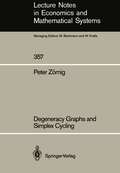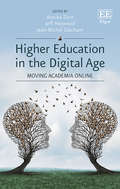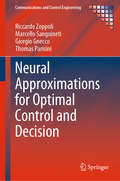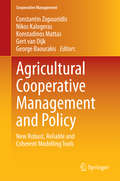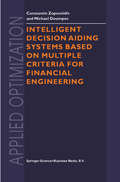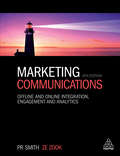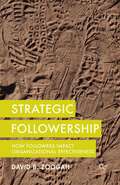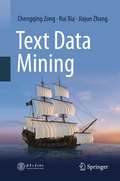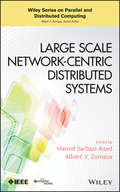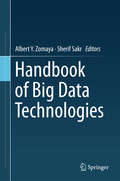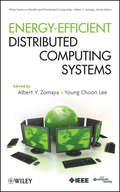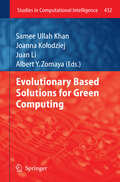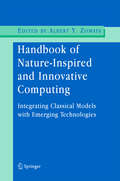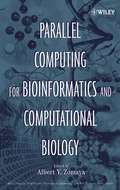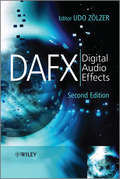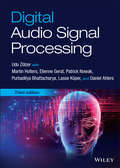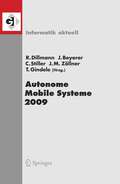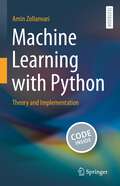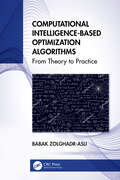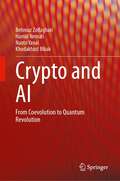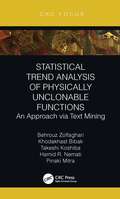- Table View
- List View
Degeneracy Graphs and Simplex Cycling (Lecture Notes in Economics and Mathematical Systems #357)
by Peter ZörnigHigher Education in the Digital Age: Moving Academia Online
by Annika Zorn Jean-Michel Glachant Jeff HaywoodThe European higher education sector is moving online, but to what extent? Are the digital disruptions seen in other sectors of relevance for both academics and management in higher education? How far are we from fully seizing the opportunities that an online transition could offer? This insightful book offers a broad perspective on existing academic practices, and discusses how and where the move online has been successful, and the lessons that can be learned. Higher Education in the Digital Age offers readers a comprehensive overview of the ways in which a move into online academia can be made. Analysing successful case studies, the original contributions to this timely book address the core activities of an academic institution – education, research, and research communication – instead of focusing only on online learning or digital strategies relevant for individual academics. Chapters cover online and networked learning, as well as the myriad ways in which the digital age can improve research and knowledge exchange with experts and society more widely. Academics, managers and policy makers in higher education institutions will greatly benefit from the up-to-date case studies and advice outlined in this book. Academic administrators and academic project leaders will also find this a useful tool for improving the accessibility of their work.
Neural Approximations for Optimal Control and Decision (Communications and Control Engineering)
by Riccardo Zoppoli Marcello Sanguineti Giorgio Gnecco Thomas ParisiniNeural Approximations for Optimal Control and Decision provides a comprehensive methodology for the approximate solution of functional optimization problems using neural networks and other nonlinear approximators where the use of traditional optimal control tools is prohibited by complicating factors like non-Gaussian noise, strong nonlinearities, large dimension of state and control vectors, etc. Features of the text include: • a general functional optimization framework; • thorough illustration of recent theoretical insights into the approximate solutions of complex functional optimization problems; • comparison of classical and neural-network based methods of approximate solution; • bounds to the errors of approximate solutions; • solution algorithms for optimal control and decision in deterministic or stochastic environments with perfect or imperfect state measurements over a finite or infinite time horizon and with one decision maker or several; • applications of current interest: routing in communications networks, traffic control, water resource management, etc.; and • numerous, numerically detailed examples. The authors’ diverse backgrounds in systems and control theory, approximation theory, machine learning, and operations research lend the book a range of expertise and subject matter appealing to academics and graduate students in any of those disciplines together with computer science and other areas of engineering.
Agricultural Cooperative Management and Policy: New Robust, Reliable and Coherent Modelling Tools (Cooperative Management)
by Constantin Zopounidis Nikos Kalogeras Konstadinos Mattas Gert Dijk George BaourakisThis book focuses on the use of farm level, micro- and macro-data of cooperative systems and networks in developing new robust, reliable and coherent modeling tools for agricultural and environmental policy analysis. The efficacy of public intervention on agriculture is largely determined by the existence of reliable information on the effects of policy options and market developments on farmers' production decisions and in particular, on key issues such as levels of agricultural and non-agricultural output, land use and incomes, use of natural resources, sustainable-centric management, structural change and the viability of family farms. Over the last years, several methods and analytical tools have been developed for policy analysis using various sets of data. Such methods have been based on integrated approaches in an effort to investigate the above key issues and have thus attempted to offer a powerful environment for decision making, particularly in an era of radical change for both agriculture and the wider economy.
Intelligent Decision Aiding Systems Based on Multiple Criteria for Financial Engineering (Applied Optimization #38)
by Constantin Zopounidis Michael DoumposThis book provides a new point of view on the field of financial engineering, through the application of multicriteria intelligent decision aiding systems. The aim of the book is to provide a review of the research in the area and to explore the adequacy of the tools and systems developed according to this innovative approach in addressing complex financial decision problems, encountered within the field of financial engineering. Audience: Researchers and professionals such as financial managers, financial engineers, investors, operations research specialists, computer scientists, management scientists and economists.
Marketing Communications: Offline and Online Integration, Engagement and Analytics
by Ze Zook Pr SmithMarketing Communications provides a comprehensive overview of every aspect of marketing communications, from social media, advertising, PR and sponsorship to direct selling and merchandizing. It presents modern marketing communications theories and tools in an accessible way so readers can fully understand the landscape and achieve better results. With a plethora of examples and case studies, as well as online support material for lecturers and students, this essential textbook will guide students and practitioners through everything they need to know about the changing face of marketing.This fully updated 6th edition of Marketing Communications features more of the underpinning theory whilst building on its impressive reputation as a leading practical textbook on the subject. Case studies and anecdotes from companies such as Campbell's Soup, Spotify, Paypal, Kraft and Nike focus on recent digital developments to bring the latest marketing tools to life. With a particular emphasis on analytics, engagement and integration, it addresses the integrated offline and online with social media approach to reflect the current state of play for marketing communications experts. This edition is also supported by a wealth of online resources, including lecture slides for every chapter and self-tests for students.Hear What the Experts Think:Angela Byrne, Senior Lecturer at MMU - https://youtu.be/04Kqku3TUqA Alison Lawson, Senior Lecturer in Marketing at Derby University - https://youtu.be/UPd56wfWC0g
Marketing Communications: Offline and Online Integration, Engagement and Analytics (PDF)
by Ze Zook Pr SmithMarketing Communications provides a comprehensive overview of every aspect of marketing communications, from social media, advertising, PR and sponsorship to direct selling and merchandizing. It presents modern marketing communications theories and tools in an accessible way so readers can fully understand the landscape and achieve better results. With a plethora of examples and case studies, as well as online support material for lecturers and students, this essential textbook will guide students and practitioners through everything they need to know about the changing face of marketing.This fully updated 6th edition of Marketing Communications features more of the underpinning theory whilst building on its impressive reputation as a leading practical textbook on the subject. Case studies and anecdotes from companies such as Campbell's Soup, Spotify, Paypal, Kraft and Nike focus on recent digital developments to bring the latest marketing tools to life. With a particular emphasis on analytics, engagement and integration, it addresses the integrated offline and online with social media approach to reflect the current state of play for marketing communications experts. This edition is also supported by a wealth of online resources, including lecture slides for every chapter and self-tests for students.Hear What the Experts Think:Angela Byrne, Senior Lecturer at MMU - https://youtu.be/04Kqku3TUqA Alison Lawson, Senior Lecturer in Marketing at Derby University - https://youtu.be/UPd56wfWC0g
Strategic Followership: How Followers Impact Organizational Effectiveness
by D. ZoogahThe concept of followership is not new, to the extent that it has been around since the beginning of time. In the organizational literature, followership (a complementary role to leadership) was ignored until recently, when scholars observed that followers play as much of a role as leaders in their relationship to each other. Followership is a role in which an individual succumbs to the influence of another person, deemed a leader. In Strategic Followership, Dr. Zoogah focuses on the recent phenomenon of strategic followership, where an individual behaves in response to a social problem either adaptively or transcendentally. In this ground-breaking work, he explores this type of followership and illustrates the various ways it can happen.
Text Data Mining
by Chengqing Zong Rui Xia Jiajun ZhangThis book discusses various aspects of text data mining. Unlike other books that focus on machine learning or databases, it approaches text data mining from a natural language processing (NLP) perspective. The book offers a detailed introduction to the fundamental theories and methods of text data mining, ranging from pre-processing (for both Chinese and English texts), text representation and feature selection, to text classification and text clustering. It also presents the predominant applications of text data mining, for example, topic modeling, sentiment analysis and opinion mining, topic detection and tracking, information extraction, and automatic text summarization. Bringing all the related concepts and algorithms together, it offers a comprehensive, authoritative and coherent overview. Written by three leading experts, it is valuable both as a textbook and as a reference resource for students, researchers and practitioners interested in text data mining. It can also be used for classes on text data mining or NLP.
Large Scale Network-Centric Distributed Systems (Wiley Series on Parallel and Distributed Computing #85)
by Albert Y. Zomaya Hamid Sarbazi-AzadA highly accessible reference offering a broad range of topics and insights on large scale network-centric distributed systems Evolving from the fields of high-performance computing and networking, large scale network-centric distributed systems continues to grow as one of the most important topics in computing and communication and many interdisciplinary areas. Dealing with both wired and wireless networks, this book focuses on the design and performance issues of such systems. Large Scale Network-Centric Distributed Systems provides in-depth coverage ranging from ground-level hardware issues (such as buffer organization, router delay, and flow control) to the high-level issues immediately concerning application or system users (including parallel programming, middleware, and OS support for such computing systems). Arranged in five parts, it explains and analyzes complex topics to an unprecedented degree: Part 1: Multicore and Many-Core (Mc) Systems-on-Chip Part 2: Pervasive/Ubiquitous Computing and Peer-to-Peer Systems Part 3: Wireless/Mobile Networks Part 4: Grid and Cloud Computing Part 5: Other Topics Related to Network-Centric Computing and Its Applications Large Scale Network-Centric Distributed Systems is an incredibly useful resource for practitioners, postgraduate students, postdocs, and researchers.
Handbook of Big Data Technologies
by Albert Y. Zomaya Sherif SakrThis handbook offers comprehensive coverage of recent advancements in Big Data technologies and related paradigms. Chapters are authored by international leading experts in the field, and have been reviewed and revised for maximum reader value. The volume consists of twenty-five chapters organized into four main parts. Part one covers the fundamental concepts of Big Data technologies including data curation mechanisms, data models, storage models, programming models and programming platforms. It also dives into the details of implementing Big SQL query engines and big stream processing systems. Part Two focuses on the semantic aspects of Big Data management including data integration and exploratory ad hoc analysis in addition to structured querying and pattern matching techniques. Part Three presents a comprehensive overview of large scale graph processing. It covers the most recent research in large scale graph processing platforms, introducing several scalable graph querying and mining mechanisms in domains such as social networks. Part Four details novel applications that have been made possible by the rapid emergence of Big Data technologies such as Internet-of-Things (IOT), Cognitive Computing and SCADA Systems. All parts of the book discuss open research problems, including potential opportunities, that have arisen from the rapid progress of Big Data technologies and the associated increasing requirements of application domains. Designed for researchers, IT professionals and graduate students, this book is a timely contribution to the growing Big Data field. Big Data has been recognized as one of leading emerging technologies that will have a major contribution and impact on the various fields of science and varies aspect of the human society over the coming decades. Therefore, the content in this book will be an essential tool to help readers understand the development and future of the field.
Energy-Efficient Distributed Computing Systems (Wiley Series on Parallel and Distributed Computing #88)
by Albert Y. Zomaya Young-Choon LeeThe energy consumption issue in distributed computing systems raises various monetary, environmental and system performance concerns. Electricity consumption in the US doubled from 2000 to 2005. From a financial and environmental standpoint, reducing the consumption of electricity is important, yet these reforms must not lead to performance degradation of the computing systems. These contradicting constraints create a suite of complex problems that need to be resolved in order to lead to 'greener' distributed computing systems. This book brings together a group of outstanding researchers that investigate the different facets of green and energy efficient distributed computing. Key features: One of the first books of its kind Features latest research findings on emerging topics by well-known scientists Valuable research for grad students, postdocs, and researchers Research will greatly feed into other technologies and application domains
Energy-Efficient Distributed Computing Systems (Wiley Series on Parallel and Distributed Computing #88)
by Albert Y. Zomaya Young Choon LeeThe energy consumption issue in distributed computing systems raises various monetary, environmental and system performance concerns. Electricity consumption in the US doubled from 2000 to 2005. From a financial and environmental standpoint, reducing the consumption of electricity is important, yet these reforms must not lead to performance degradation of the computing systems. These contradicting constraints create a suite of complex problems that need to be resolved in order to lead to 'greener' distributed computing systems. This book brings together a group of outstanding researchers that investigate the different facets of green and energy efficient distributed computing. Key features: One of the first books of its kind Features latest research findings on emerging topics by well-known scientists Valuable research for grad students, postdocs, and researchers Research will greatly feed into other technologies and application domains
Evolutionary Based Solutions for Green Computing (Studies in Computational Intelligence #432)
by Albert Y. Zomaya Samee Ullah Khan Joanna Ko 322 Odziej Juan LiToday’s highly parameterized large-scale distributed computing systems may be composed of a large number of various components (computers, databases, etc) and must provide a wide range of services. The users of such systems, located at different (geographical or managerial) network cluster may have a limited access to the system’s services and resources, and different, often conflicting, expectations and requirements. Moreover, the information and data processed in such dynamic environments may be incomplete, imprecise, fragmentary, and overloading. All of the above mentioned issues require some intelligent scalable methodologies for the management of the whole complex structure, which unfortunately may increase the energy consumption of such systems. An optimal energy utilization has reached to a point that many information technology (IT) managers and corporate executives are all up in arms to identify scalable solution that can reduce electricity consumption (so that the total cost of operation is minimized) of their respective large-scale computing systems and simultaneously improve upon or maintain the current throughput of the system. This book in its eight chapters, addresses the fundamental issues related to the energy usage and the optimal low-cost system design in high performance ``green computing’’ systems. The recent evolutionary and general metaheuristic-based solutions for energy optimization in data processing, scheduling, resource allocation, and communication in modern computational grids, could and network computing are presented along with several important conventional technologies to cover the hot topics from the fundamental theory of the ‘’green computing’’ concept and to describe the basic architectures of systems. This book points out the potential application areas and provides detailed examples of application case studies in low-energy computational systems. The development trends and open research issues are also outlined. All of those technologies have formed the foundation for the green computing that we know of today.
Handbook of Nature-Inspired and Innovative Computing: Integrating Classical Models with Emerging Technologies
by Albert Y. ZomayaAs computing devices proliferate, demand increases for an understanding of emerging computing paradigms and models based on natural phenomena. Neural networks, evolution-based models, quantum computing, and DNA-based computing and simulations are all a necessary part of modern computing analysis and systems development. Vast literature exists on these new paradigms and their implications for a wide array of applications. This comprehensive handbook, the first of its kind to address the connection between nature-inspired and traditional computational paradigms, is a repository of case studies dealing with different problems in computing and solutions to these problems based on nature-inspired paradigms. The "Handbook of Nature-Inspired and Innovative Computing: Integrating Classical Models with Emerging Technologies" is an essential compilation of models, methods, and algorithms for researchers, professionals, and advanced-level students working in all areas of computer science, IT, biocomputing, and network engineering.
Parallel Computing for Bioinformatics and Computational Biology: Models, Enabling Technologies, and Case Studies (Wiley Series on Parallel and Distributed Computing #55)
by Albert Y. ZomayaDiscover how to streamline complex bioinformatics applications with parallel computing This publication enables readers to handle more complex bioinformatics applications and larger and richer data sets. As the editor clearly shows, using powerful parallel computing tools can lead to significant breakthroughs in deciphering genomes, understanding genetic disease, designing customized drug therapies, and understanding evolution. A broad range of bioinformatics applications is covered with demonstrations on how each one can be parallelized to improve performance and gain faster rates of computation. Current parallel computing techniques and technologies are examined, including distributed computing and grid computing. Readers are provided with a mixture of algorithms, experiments, and simulations that provide not only qualitative but also quantitative insights into the dynamic field of bioinformatics. Parallel Computing for Bioinformatics and Computational Biology is a contributed work that serves as a repository of case studies, collectively demonstrating how parallel computing streamlines difficult problems in bioinformatics and produces better results. Each of the chapters is authored by an established expert in the field and carefully edited to ensure a consistent approach and high standard throughout the publication. The work is organized into five parts: * Algorithms and models * Sequence analysis and microarrays * Phylogenetics * Protein folding * Platforms and enabling technologies Researchers, educators, and students in the field of bioinformatics will discover how high-performance computing can enable them to handle more complex data sets, gain deeper insights, and make new discoveries.
DAFX: Digital Audio Effects
by Udo ZölzerThe rapid development in various fields of Digital Audio Effects, or DAFX, has led to new algorithms and this second edition of the popular book, DAFX: Digital Audio Effects has been updated throughout to reflect progress in the field. It maintains a unique approach to DAFX with a lecture-style introduction into the basics of effect processing. Each effect description begins with the presentation of the physical and acoustical phenomena, an explanation of the signal processing techniques to achieve the effect, followed by a discussion of musical applications and the control of effect parameters. Topics covered include: filters and delays, modulators and demodulators, nonlinear processing, spatial effects, time-segment processing, time-frequency processing, source-filter processing, spectral processing, time and frequency warping musical signals. Updates to the second edition include: Three completely new chapters devoted to the major research areas of: Virtual Analog Effects, Automatic Mixing and Sound Source Separation, authored by leading researchers in the field . Improved presentation of the basic concepts and explanation of the related technology. Extended coverage of the MATLABTM scripts which demonstrate the implementation of the basic concepts into software programs. Companion website (www.dafx.de) which serves as the download source for MATLABTM scripts, will be updated to reflect the new material in the book. Discussing DAFX from both an introductory and advanced level, the book systematically introduces the reader to digital signal processing concepts, how they can be applied to sound and their use in musical effects. This makes the book suitable for a range of professionals including those working in audio engineering, as well as researchers and engineers involved in the area of digital signal processing along with students on multimedia related courses.
Digital Audio Signal Processing
by Udo ZölzerDigital Audio Signal Processing The fully revised new edition of the popular textbook, featuring additional MATLAB exercises and new algorithms for processing digital audio signals Digital Audio Signal Processing (DASP) techniques are used in a variety of applications, ranging from audio streaming and computer-generated music to real-time signal processing and virtual sound processing. Digital Audio Signal Processing provides clear and accessible coverage of the fundamental principles and practical applications of digital audio processing and coding. Throughout the book, the authors explain a wide range of basic audio processing techniques and highlight new directions for automatic tuning of different algorithms and discuss state- of-the-art DASP approaches. Now in its third edition, this popular guide is fully updated with the latest signal processing algorithms for audio processing. Entirely new chapters cover nonlinear processing, Machine Learning (ML) for audio applications, distortion, soft/hard clipping, overdrive, equalizers and delay effects, sampling and reconstruction, and more. Covers the fundamentals of quantization, filters, dynamic range control, room simulation, sampling rate conversion, and audio coding Describes DASP techniques, their theoretical foundations, and their practical applications Discusses modern studio technology, digital transmission systems, storage media, and home entertainment audio components Features a new introductory chapter and extensively revised content throughout Provides updated application examples and computer-based activities supported with MATLAB exercises and interactive JavaScript applets via an author-hosted companion website Balancing essential concepts and technological topics, Digital Audio Signal Processing, Third Edition remains the ideal textbook for advanced music technology and engineering students in audio signal processing courses. It is also an invaluable reference for audio engineers, hardware and software developers, and researchers in both academia and industry.
Digital Audio Signal Processing
by Udo ZölzerDigital Audio Signal Processing The fully revised new edition of the popular textbook, featuring additional MATLAB exercises and new algorithms for processing digital audio signals Digital Audio Signal Processing (DASP) techniques are used in a variety of applications, ranging from audio streaming and computer-generated music to real-time signal processing and virtual sound processing. Digital Audio Signal Processing provides clear and accessible coverage of the fundamental principles and practical applications of digital audio processing and coding. Throughout the book, the authors explain a wide range of basic audio processing techniques and highlight new directions for automatic tuning of different algorithms and discuss state- of-the-art DASP approaches. Now in its third edition, this popular guide is fully updated with the latest signal processing algorithms for audio processing. Entirely new chapters cover nonlinear processing, Machine Learning (ML) for audio applications, distortion, soft/hard clipping, overdrive, equalizers and delay effects, sampling and reconstruction, and more. Covers the fundamentals of quantization, filters, dynamic range control, room simulation, sampling rate conversion, and audio coding Describes DASP techniques, their theoretical foundations, and their practical applications Discusses modern studio technology, digital transmission systems, storage media, and home entertainment audio components Features a new introductory chapter and extensively revised content throughout Provides updated application examples and computer-based activities supported with MATLAB exercises and interactive JavaScript applets via an author-hosted companion website Balancing essential concepts and technological topics, Digital Audio Signal Processing, Third Edition remains the ideal textbook for advanced music technology and engineering students in audio signal processing courses. It is also an invaluable reference for audio engineers, hardware and software developers, and researchers in both academia and industry.
Autonome Mobile Systeme 2009: 21. Fachgespräch Karlsruhe, 3./4. Dezember 2009 (Informatik aktuell)
by Marius Zöllner Tobias Gindele Rüdiger Dillmann Jürgen Beyerer Christoph StillerDer Band dokumentiert das 21. Fachgespräch Autonome Mobile Systeme (AMS 2009). Die Veranstaltung bietet Wissenschaftlern aus Forschung und Industrie ein Forum für den Gedankenaustausch und eine Basis, um Kooperationen auf diesem Forschungsgebiet zu initiieren. Die Beiträge befassen sich mit Themen wie humanoide Roboter und Flugmaschinen, Perzeption und Sensorik, Kartierung und Lokalisation, Regelung, Navigation, Lernverfahren, Systemarchitekturen sowie mit der Anwendung von autonomen mobilen Systemen.
Machine Learning with Python: Theory and Implementation
by Amin ZollanvariThis book is meant as a textbook for undergraduate and graduate students who are willing to understand essential elements of machine learning from both a theoretical and a practical perspective. The choice of the topics in the book is made based on one criterion: whether the practical utility of a certain method justifies its theoretical elaboration for students with a typical mathematical background in engineering and other quantitative fields. As a result, not only does the book contain practically useful techniques, it also presents them in a mathematical language that is accessible to both graduate and advanced undergraduate students. The textbook covers a range of topics including nearest neighbors, linear models, decision trees, ensemble learning, model evaluation and selection, dimensionality reduction, assembling various learning stages, clustering, and deep learning along with an introduction to fundamental Python packages for data science and machine learning such as NumPy, Pandas, Matplotlib, Scikit-Learn, XGBoost, and Keras with TensorFlow backend. Given the current dominant role of the Python programming language for machine learning, the book complements the theoretical presentation of each technique by its Python implementation. In this regard, two chapters are devoted to cover necessary Python programming skills. This feature makes the book self-sufficient for students with different programming backgrounds and is in sharp contrast with other books in the field that assume readers have prior Python programming experience. As such, the systematic structure of the book, along with the many examples and exercises presented, will help the readers to better grasp the content and be equipped with the practical skills required in day-to-day machine learning applications.
Computational Intelligence-based Optimization Algorithms: From Theory to Practice
by Babak Zolghadr-AsliComputational intelligence-based optimization methods, also known as metaheuristic optimization algorithms, are a popular topic in mathematical programming. These methods have bridged the gap between various approaches and created a new school of thought to solve real-world optimization problems. In this book, we have selected some of the most effective and renowned algorithms in the literature. These algorithms are not only practical but also provide thought-provoking theoretical ideas to help readers understand how they solve optimization problems. Each chapter includes a brief review of the algorithm’s background and the fields it has been used in. Additionally, Python code is provided for all algorithms at the end of each chapter, making this book a valuable resource for beginner and intermediate programmers looking to understand these algorithms.
Computational Intelligence-based Optimization Algorithms: From Theory to Practice
by Babak Zolghadr-AsliComputational intelligence-based optimization methods, also known as metaheuristic optimization algorithms, are a popular topic in mathematical programming. These methods have bridged the gap between various approaches and created a new school of thought to solve real-world optimization problems. In this book, we have selected some of the most effective and renowned algorithms in the literature. These algorithms are not only practical but also provide thought-provoking theoretical ideas to help readers understand how they solve optimization problems. Each chapter includes a brief review of the algorithm’s background and the fields it has been used in. Additionally, Python code is provided for all algorithms at the end of each chapter, making this book a valuable resource for beginner and intermediate programmers looking to understand these algorithms.
Crypto and AI: From Coevolution to Quantum Revolution
by Behrouz Zolfaghari Hamid Nemati Naoto Yanai Khodakhast BibakThis book studies the intersection between cryptography and AI, highlighting the significant cross-impact and potential between the two technologies. The authors first study the individual ecosystems of cryptography and AI to show the omnipresence of each technology in the ecosystem of the other one. Next, they show how these technologies have come together in collaborative or adversarial ways. In the next section, the authors highlight the coevolution being formed between cryptography and AI. Throughout the book, the authors use evidence from state-of-the-art research to look ahead at the future of the crypto-AI dichotomy. The authors explain how they anticipate that quantum computing will join the dichotomy in near future, augmenting it to a trichotomy. They verify this through two case studies highlighting another scenario wherein crypto, AI and quantum converge. The authors study current trends in chaotic image encryption as well as information-theoretic cryptography and show how these trends lean towards quantum-inspired artificial intelligence (QiAI). After concluding the discussions, the authors suggest future research for interested researchers.
Statistical Trend Analysis of Physically Unclonable Functions: An Approach via Text Mining
by Behrouz Zolfaghari Khodakhast Bibak Takeshi Koshiba Hamid R. Nemati Pinaki MitraPhysically Unclonable Functions (PUFs) translate unavoidable variations in certain parameters of materials, waves, or devices into random and unique signals. They have found many applications in the Internet of Things (IoT), authentication systems, FPGA industry, several other areas in communications and related technologies, and many commercial products. Statistical Trend Analysis of Physically Unclonable Functions first presents a review on cryptographic hardware and hardware-assisted cryptography. The review highlights PUF as a mega trend in research on cryptographic hardware design. Afterwards, the authors present a combined survey and research work on PUFs using a systematic approach. As part of the survey aspect, a state-of-the-art analysis is presented as well as a taxonomy on PUFs, a life cycle, and an established ecosystem for the technology. In another part of the survey, the evolutionary history of PUFs is examined, and strategies for further research in this area are suggested. In the research side, this book presents a novel approach for trend analysis that can be applied to any technology or research area. In this method, a text mining tool is used which extracts 1020 keywords from the titles of the sample papers. Then, a classifying tool classifies the keywords into 295 meaningful research topics. The popularity of each topic is then numerically measured and analyzed over the course of time through a statistical analysis on the number of research papers related to the topic as well as the number of their citations. The authors identify the most popular topics in four different domains; over the history of PUFs, during the recent years, in top conferences, and in top journals. The results are used to present an evolution study as well as a trend analysis and develop a roadmap for future research in this area. This method gives an automatic popularity-based statistical trend analysis which eliminates the need for passing personal judgments about the direction of trends, and provides concrete evidence to the future direction of research on PUFs. Another advantage of this method is the possibility of studying a whole lot of existing research works (more than 700 in this book). This book will appeal to researchers in text mining, cryptography, hardware security, and IoT.
